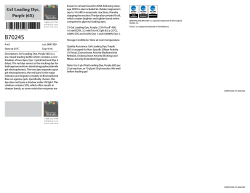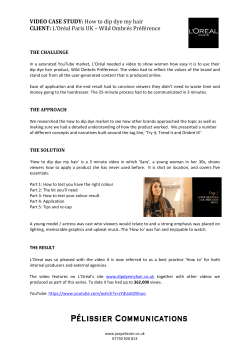
Rubric - Mrs. Nielsen Science
Mrs. Nielsen
AP Chemistry
Name __________________________________ Date __________________ Period ____
Analysis of Food Dyes in Beverages
Objective
Students will use spectroscopy and graphical analysis to determine the concentration of dye
in a sports drink. The investigation will develop skills in preparing accurate serial dilutions,
understanding spectroscopic measurements, and extrapolating from graphical data.
Concepts
! Spectroscopy
! Absorbance vs. Transmittance
! Wavelength
!
!
!
Consumer Science
Beer’s Law
Solution Concentration
Introduction
The color of a solution is an important tool used by scientists to gain information about the
composition of the solution. Color is a physical property that is useful for both qualitative and
quantitative analysis. A qualitative method yields information about the nature or type of
compound in a sample, whereas a quantitative method provides numerical data for the amount of a
compound in a sample.
Spectroscopy is the study of the interaction of light and matter. A spectrophotometer is
an instrument that uses radiation from a selected region of the electromagnetic spectrum, such as
ultraviolet, visible or infrared, to analyze the absorption or transmission of light by a sample. The
basic function of a spectrophotometer is shown in Figure 1. The electromagnetic spectrum (see
Figure 2) is the entire range of possible wavelengths or frequencies of electromagnetic radiation.
In this investigation a visible spectrophotometer will be used – it spans the visible region of the
electromagnetic spectrum, from 380 nm to 750 nm. Typical light sources for visible
spectrophotometers include xenon and tungsten lamps.
Glass cuvettes or test tubes may be used as sample cells for visible spectrophotometers. In
addition to the energy source used in spectrophotometers, a diffraction grating called a
monochromator is also incorporated. The monochromator spreads the beam of light into the light's
component wavelengths. The desired wavelength is then focused onto the sample cell to detect
any absorption or emission of light by a substance in a sample.
Adapted from Flinn Scientific November 14, 2014
Mrs. Nielsen
AP Chemistry
Spectrophotometry is an analytical procedure that uses electromagnetic radiation to
measure the concentration of a substance. The success of a spectrophotometric technique
requires that the absorption of light by the substance being analyzed must be distinct or
different from that of other chemical species in solution. How do scientists select the desired
wavelength for spectrophotometry?
The absorption of visible light by a substance results from electron transitions, that is, the
promotion of a ground state electron to a higher energy atomic or molecular orbital. Both light
energy and electron energy levels are quantized, so that the specific wavelength of light
absorbed by a substance depends on the energy difference between two electron energy levels.
The optimum wavelength for spectrophotometric analysis of a substance is selected by measuring
the visible spectrum of the substance, corresponding to a plot of absorbance (A) versus
wavelength (A, "lambda").
The Food and Drug Administration approves only seven unique dyes for use in foods, drugs
and cosmetics. These seven FD&C dyes give rise to the entire palette of artificial food colors. The
structure of FD&C Blue 1 is shown in Figure 3. Notice the extensive series of alternating single
and double bonds (also called conjugated double bonds) in the center of the structure. This feature is characteristic of intensely colored organic dyes and pigments.
A solution containing FD&C Blue 1 appears blue under normal white light - this is the color
of light transmitted by the solution. The colors or wavelengths of light that are absorbed by this
solution are complementary to the transmitted color. A color wheel (see Figure 4) provides a
useful tool for identifying the colors or wavelengths of light absorbed by a substance. The blue
solution absorbs yellow, orange and red light and we would expect the visible spectrum of FD&C
Blue 1 to contain a peak in the 580-750 nm region. The optimum wavelength for
spectrophotometric analysis of a dye solution generally determined from the wavelength of
maximum absorbance (abbreviated λmax or "lambda max"). The value of lambda max for FD&C Blue
1 is 630 nm.
Adapted from Flinn Scientific November 14, 2014
Mrs. Nielsen
AP Chemistry
The wavelength of light absorbed by a substance is dependent on its molecular or
electronic structure. The intensity of light absorbed depends on the amount of the substance in
solution. Generally, the more concentrated the solution, the more intense the color will be, and
the greater the intensity of light the solution absorbs. A digital spectrophotometer measures both
the percent transmittance of light and the absorbance. When light is absorbed, the radiant power
(P) of the light beam decreases. Transmittance (T) is the fraction of incident light (P/P0) that
passes through the sample (see Figure 5). The relationships between transmittance and percent
transmittance (% T) and between transmittance and absorbance (A) are given in Equations 1 and 2,
respectively. Absorbance values are most accurate within the range of 0.2-1.
The amount of light absorbed by a solution depends on its concentration (c) as well as the
path length of the sample cell (b) through which the light must travel. See Equation 3, which is
known as Beer's law. The constant ε ("epsilon") in the equation is a characteristic of a substance
and is known as the molar absorptivity coefficient.
A =ε b c
Equation 3
Adapted from Flinn Scientific November 14, 2014
Mrs. Nielsen
AP Chemistry
Day 1: Introductory Activity – Constructing a Calibration Curve
*Do NOT write these sections in your lab notebook
Purpose:
Students will work cooperatively to prepare a series of standard dilutions from an FD&C
Blue 1 stock solution and measure the percent transmittance of each. The results will be analyzed
graphically to identify an optimum linear relationship among various functions (T, % T, log T and A)
for a Beer's law calibration curve. The procedure provides a model for guided-inquiry analysis of
the concentration of food dye(s) in sports drinks and other consumer beverages.
Background Knowledge
The visible absorption spectrum for FD&C Blue 1 is shown in Figure 6. The estimated concentration
of the dye was 7.0 µM (7.0 x l0-6 M).
1. What would be an optimum wavelength for measuring the absorbance versus concentration of a
series of FD&C Blue 1 dye solutions? Explain your answer. Absorbance measurements are most
accurate and sensitive in the range 0.2-1.0.
2. To construct a calibration curve, a series of known concentration standards is prepared. Using
the estimated concentration of the FD&C Blue 1 stock solution, determine the concentration of
each of the following dilutions. Show your calculation for at least one solution in the space below.
Hint: M1V1 = M2V2
Dye Stock
Solution (A)
B
C
D
E
F
G
H
Concentration (μM)
7.0 μM
Water Volume (mL)
0
2
4
6
7
8
9
10
10
8
6
4
3
2
1
0
Stock Solution Volume
(mL)
Predicted Absorbance (A)
Adapted from Flinn Scientific November 14, 2014
Mrs. Nielsen
AP Chemistry
3. Using the information provided in Question 1, predict the absorbance of each solution A-H at
the optimum wavelength. Refer to Equation 3 in the Introduction section. The value of ε is
130,000 M-1cm-1. The value of b is 1 cm. Show your calculation for at least one solution in the
space below.
Materials
! FC&C Blue 1 stock solution, 50 mL
! Sample of consumer sports drink, 10 mL
! Distilled water
! Beakers, 50 mL, 2-3
! Cuvets or test tubes, 13 x 100 mm
!
!
!
!
Kimwipes or lens tissues
Pipet, 10 mL
Spectrophotometer
Test tube rack
Procedure
Safety: The FD&C dyes are slightly hazardous by eye and skin contact. The dyes have been
stored with other, nonfood-grade chemicals and are not for consumption. Wear chemical
splash goggles and a chemical-resistant apron. Wash hands thoroughly with soap and water
before leaving the laboratory.
Protocol:
1. Tum the spectrophotometer on and allow to warm up for 15-20 minutes.
2. Based on the maximum absorbance of the dye tested, select the appropriate wavelength
on the spectrophotometer.
3. Calibrate the spectrophotometer with the blank (100% T) and chalk (0% T).
4. Using a pipet with accurate volume measurements, dilute the stock solution as indicated
in the following table to prepare 10 mL of each standard solution, B-H. Thoroughly mix each
solution. As a part of a cooperative lab activity, your instructor will assign different groups
to prepare and analyze different solutions. Each group will transcribe the data and
analyze the results from all solutions.
Stock
(A)
B
C
D
E
F
G
Blank
(H)
Water Volume (mL)
0
2
4
6
7
8
9
10
Stock Solution Volume (mL)
10
8
6
4
3
2
1
0
5. Measure and record the percent transmittance (% T) of the stock solution and each
standard solution (B-H) at the optimum wavelength.
Adapted from Flinn Scientific November 14, 2014
Mrs. Nielsen
AP Chemistry
Data
Solution
Dilution Ratio
(mL stock/mL water)
Concentration
(μM)
% T
Transmittance
(T)
Absorbance
(-log T)
Stock (A)
B
C
D
E
F
G
H
Data Processing
1. Convert % T to transmittance (T) for each measurement, and calculate the value of absorbance
(A = -log T). Record all results.
2. Based on your absorbance values, use Beer's law to calculate the precise concentration of FD&C
Blue 1 in the stock solution. The molar absorptivity (ε) of FD&C Blue 1 is 130,000 M-1cm-1 at 630
nm and the path length (b) is 1 cm. Record the micromolar (μM) concentration (1 μM = 1 X 10-6 M)
in your data table.
3. Using Excel, or a similar graphing program, prepare (3) separate graphs of (a) % T, (b) T, and
(c) -log T (on the y-axis) versus dye concentration (on the x-axis) for each solution. Note: Dye
concentrations were calculated in the Pre Lab Questions using the estimated concentration of the
stock solution. For your graphs, use the recalculated concentrations of solutions B-G, based on
your absorption data.
Adapted from Flinn Scientific November 14, 2014
Mrs. Nielsen
AP Chemistry
Day 2: Guided-Inquiry Design and Procedure
Concentration of FD&C Blue 1 in Beverages
* Write these sections in your Lab Notebook
Purpose
Students will use data from the Introductory Activity to design and implement a procedure using
spectrophotometers to determine the concentration of dye in a sports drink.
Background Knowledge
1. Based on the graphs obtained in the Introductory Activity, identify the optimum linear
relationship or calibration curve for quantitative analysis of the concentration of an "unknown"
solution containing FD&C Blue 1 food dye. Paste the appropriate graph in your lab notebook.
2. How can this graph be used to identify the concentration of FD&C Blue 1 Food Dye in an
"unknown" solution whose transmittance has been measured spectroscopically? Explain in terms of
Beer's law and provide an example of how the analysis would be carried out.
3. Consult the ingredients label for a blue-colored sports drink or other consumer beverage.
Identify the dyes that are present and explain whether the beverage can be analyzed using the
calibration curve above.
Materials
Write a bulleted list of materials needed to carry out this experiment. Include the
chemicals needed, glassware, and equipment.
Procedure
Safety - Review the hazards of the chemicals used in the lab and write appropriate safety
precautions that must be followed during the experiment
Protocol - Write a detailed protocol with numbered, imperative instructions for analyzing
the concentration of FD&C Blue 1 food dye in the beverage sample.
Data
Spectrophotometry Data
% Transmittance (%T)
Transmittance (T)
Absorbance (-log T)
Adapted from Flinn Scientific November 14, 2014
Mrs. Nielsen
AP Chemistry
Data Processing
1. Use the formula for the best fit line on the calibration curve to determine the
concentration (micromolar, μM) of the dye in the beverage.
2. Calculate the mass of dye (in milligrams) contained in one liter of the beverage. The
molar mass of FD&C Blue 1 is 793 g/mol.
Discussion Questions:
1. Calculate the value of %T for an absorbance of 1.5. Use the result to speculate why
absorbance measurements >1 are less accurate.
For Questions 2-4, consider the following: Spectrophotometeric studies can be conducted on
any colored compound. The transition metal group of the periodic table exhibits a wide
array of different colored compounds. In aqueous solutions, Cu2+ ions will bond to six water
molecules forming a complex ion, [Cu(H2O)6] 2+, which is a light blue color. The water
molecules can be displaced by ammonia molecules, which are which are stronger Lewis bases
than water. The complex ion tetraaminecopper(II) contains four ammonia molecules
covalently bonded to a copper (II) ion. The appearance of the intense dark blue-violet color
of the [Cu(NH3)4] 2+ ion is often used as a positive test to verify the presence of the complex
ions.
2. Write a balanced chemical equation for the reaction of copper (II) sulfate and ammonia
to produce tetraaminecopper(II) sulfate.
3. [Cu(NH3)4]2+ solutions exhibit a deep blue-violet color. Would you expect the wavelength
of maximum absorbance (λmax) for [Cu(NH3)4]2+ to be greater than or less than the λmax for
[Cu(H2O)6]2+?
4. The electron transitions responsible for the colors of transition metal ions involve d" d
transitions. Why are zinc ions colorless in aqueous solution?
Conclusion/ Analysis: Write 1 paragraph that includes the following:
1) What is the purpose of this lab?
2) How is a calibration curve useful for identifying the concentration of an unknown
solution?
3) How is Beer’s Law applied in this investigation?
4) Include an error analysis, how can the results be improved?
Adapted from Flinn Scientific November 14, 2014
© Copyright 2025

















